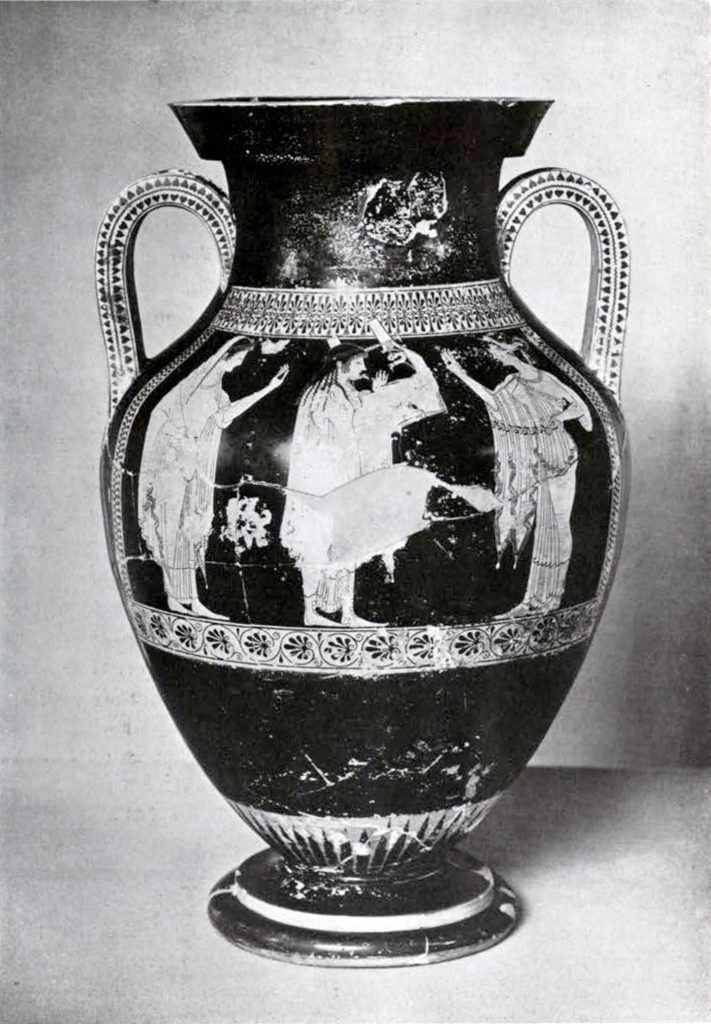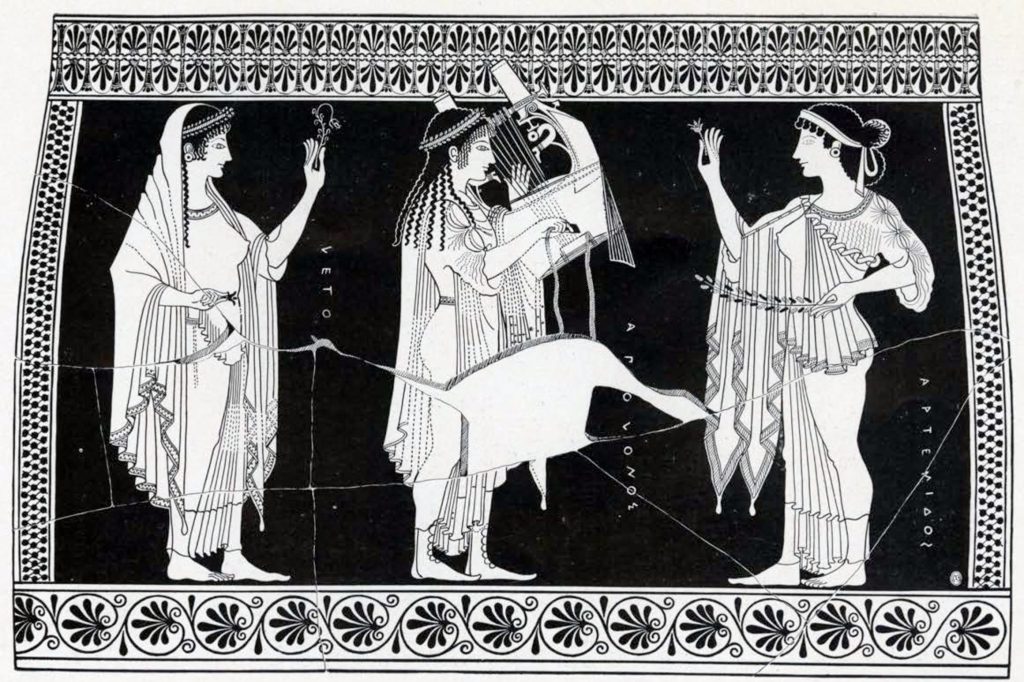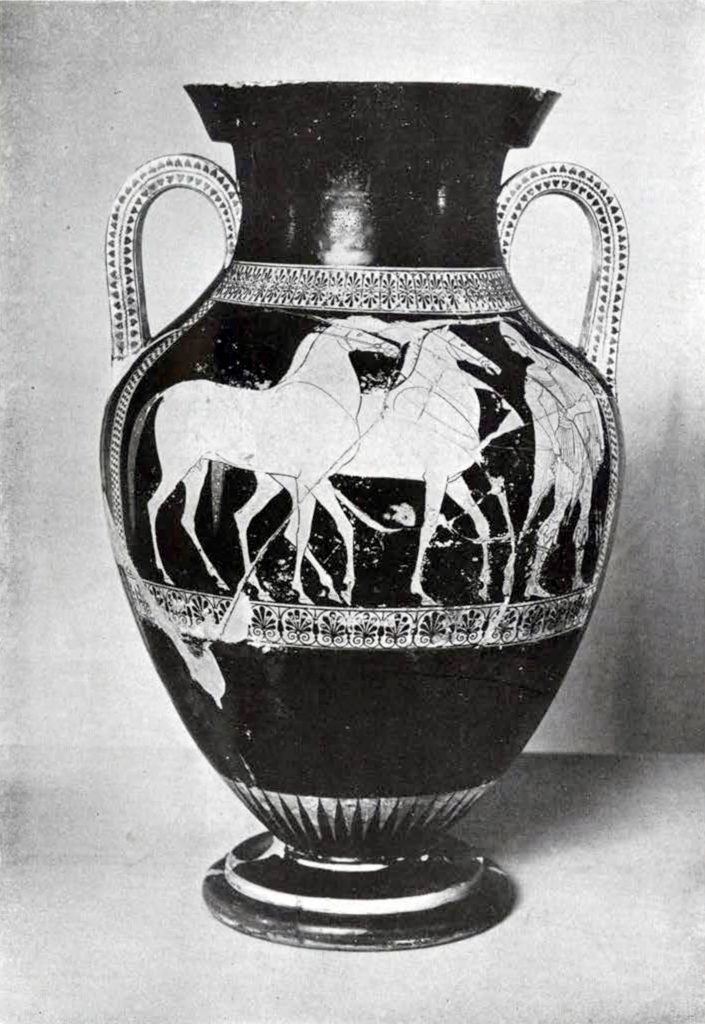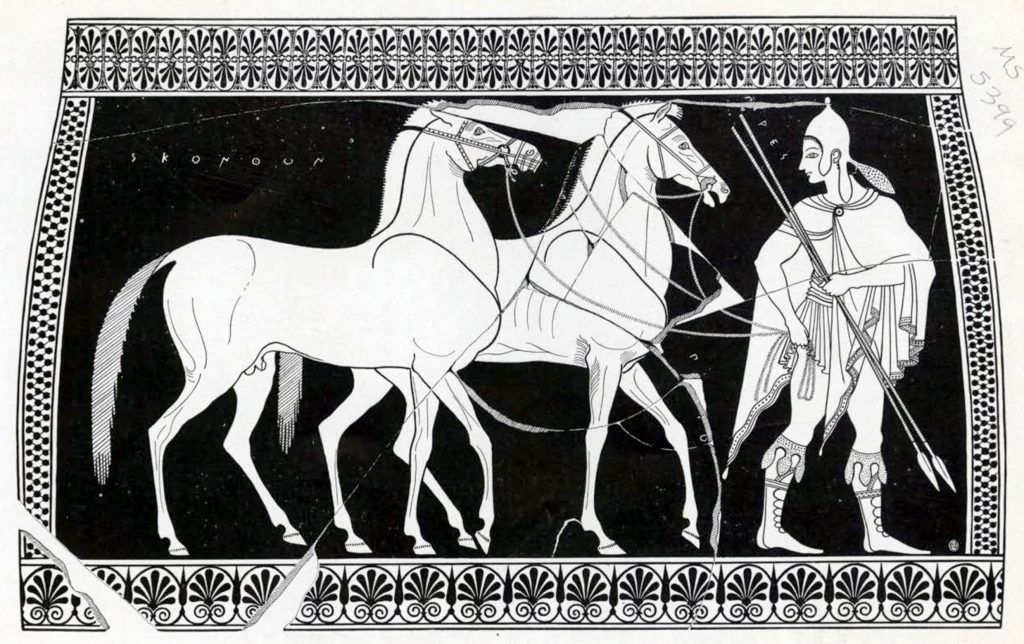The Museum has had in its possession since 1896 a red-figured amphora decorated with two scenes which for precision, delicacy, and vigor of drawing compare favorably with the best work produced by Attic vase-painters of the early period. On the foot of the vase are scratched the words Μενονεποιεσεν, Mena made (me). Nothing is known of this potter Meno; the name is new. The style of decoration, on the contrary, conforms entirely to that of the vase-painter Andokides who flourished in the latter half of the sixth century B. C. Especially striking is the resemblance borne by the scene on the obverse (Figs. 17 and 18) to that on an amphora in the Archaeological Museum in Madrid, which is signed by Andokides. There the same subject is represented, Leto with her children Apollo and Artemis and neither the difference in the ordering of the figures nor the addition of a fourth personage, an armed warrior, diminishes the resemblance. The shape of the vase, the kind of ornament which frames the scene, the posing of the figures, the treatment of drapery, the gestures, all are alike on the
two vases.

Museum Object Number: MS5399
Image Number: 3004
These similarities in the paintings of Andokides and those of the vase which I am describing have already been pointed out both by Professor W. N. Bates in the American Journal of Archaeology for 1905 and again in a subsequent number of the same periodical where both Professor Bates and Professor D. M. Robinson of Johns Hopkins University discussed the vase in detail. The main point at issue was the interpretation of the inscriptions which are incised beside the various figures in the two scenes, and this is again the center of interest since, as a result of a recent cleaning of the vase, one new inscription and several new letters have come to light.
The three inscriptions on the obverse offer no difficulties; they are written vertically beside the figures of the three gods and are all in the genitive, Λετος, Απολονος, Αρτεμιζος, that is to say, the picture of Leto, the picture of Apollo, the picture of Artemis. In the inscription beside the figure of Leto, the final letter has been almost entirely destroyed by the flaking off of the black glaze. The small bit which remains was not detected before the vase was cleaned nor were the last four letters of Apollo’s name and the final letter of the inscription beside the figure of Artemis.
The subject of the decoration on the reverse of the vase may be seen from Figs. 19 and 20. A man wearing a close fitting cap, a cloak, and high boots, and carrying two spears, leads a pair of horses, one of which is bridled as if for riding, the other of which is fitted with a halter and muzzle as if for being led. Of the inscriptions on this face of the vase, two were visible before the vase was cleaned. The former, σκονθον is written horizontally above the head of the rear horse. This inscription rightly interpreted by Professor Robinson as the genitive plural, ξανθών, (of the reddish horses), refers, of course, to the pair. The other inscription, hitherto visible, consisted of three letters ρες written parallel to the head of the forward horse. Noel des Vergers, who first published the vase, thought that this might be for Rhesos, and refer to the man. Professor Bates suggested κρές which would, of course, mean that the horse was Cretan. Professor Robinson rightly conjectured that something was to be supplied before not after these three letters, and suggested Φέρες a well-known name for a horse shortened from Φερένικος “victorious.” When the vase was cleated there appeared above the horizontal crack which traverses this part of the vase, the letter π. One letter was apparently lost in the crack. Professor Robinson’s conjecture might still be regarded as the best, and the π be regarded as a potter’s barbarism for Φ were it not for the fact that a remnant of the lost letter is apparent below the crack and this remnant appears to be the lower part of an υ. If this be so, the original inscription must have been πυρες. A search through the lists of names given by the Greeks to their horses, shows that πυρρός or the form πυρός “fiery red” was a common name. The feminine for this name πυρρία also occurs and I believe that we have here a shortened form of the latter name written in the genitive as are all the other names on the vase. The ε is in that case for α.

Museum Object Number: MS5399
Image Number: 3005
A new inscription, no letters of which were previously detected, also came to light beside the advanced leg of the forward horse. Unfortunately a large vertical crack runs just along the line of the inscription so that only a few letters can be deciphered. These are the letter π and after a space where the surface of the vase is injured, the vertical stroke of another letter, and at the end the letter ο. Between the first letter and the letter represented by the vertical stroke there is room for two or at the most for three letters according as to whether they were regularly or irregularly spaced. If we search in the lists of horses’ names for those which fit these conditions, we find πιστό “faithful,” the o in that case standing for ου of the genitive. Or again, if two different spellings of a name might be assumed for the same vase, this inscription might be read as πυρρό and the two be interpreted, “of the fire-red mare ” and ” of the fire-red horse,” a reading which would harmonize well with the other inscription referring to the pair.

Museum Object Number: MS5399
Image Number: 3011
One other point in regard to this vase deserves, perhaps, further comment and that is the costume worn by the man who leads the horses. It is that described by Herodotos in his enumeration of the various allies of the Persians and of their martial equipment. “The Thracians,” wrote he, “joined the expedition, having fox-skin caps on their heads and chitons around their bodies and over them they were clothed with many colored cloaks, and on their feet and legs they had buskins of fawn-skin.” This costume is depicted with great care on the vase before us. The cap of fox-skin is not unlike the fur cap worn today by the inhabitants of the north Balkan countries as a protection against the severe cold of winter. It is a peaked cap ornamented behind with the fox’s brush, the long hair of which is here indicated by stippling. The four paws of the skin are worn two behind and two in front of the ears. The boots extend nearly to the knee and the overhanging tops of fur, a feature mentioned by more than one classical author, are clearly shown.
The original publication of this vase was made by Noel des Vergers in 1864. It is interesting to note that a reproduction of the figure of a Thracian warrior taken from this early publication is to be found in Daremberg and Saglio’s Dictionnaire des antiquités s. v. alopekos, the Greek word for a cap of fox-skin. It was apparently chosen as a trustworthy representation of Thracian costume because the author followed Noel des Vergers in his interpretation of the inscription ρες as Rhesos, and Rhesos was known to have come from Thrace. This reading of the inscription we now know to be impossible, but the costume may nevertheless be regarded as typically Thracian.
E. H. H.

Museum Object Number: MS5399
Image Number: 3014

